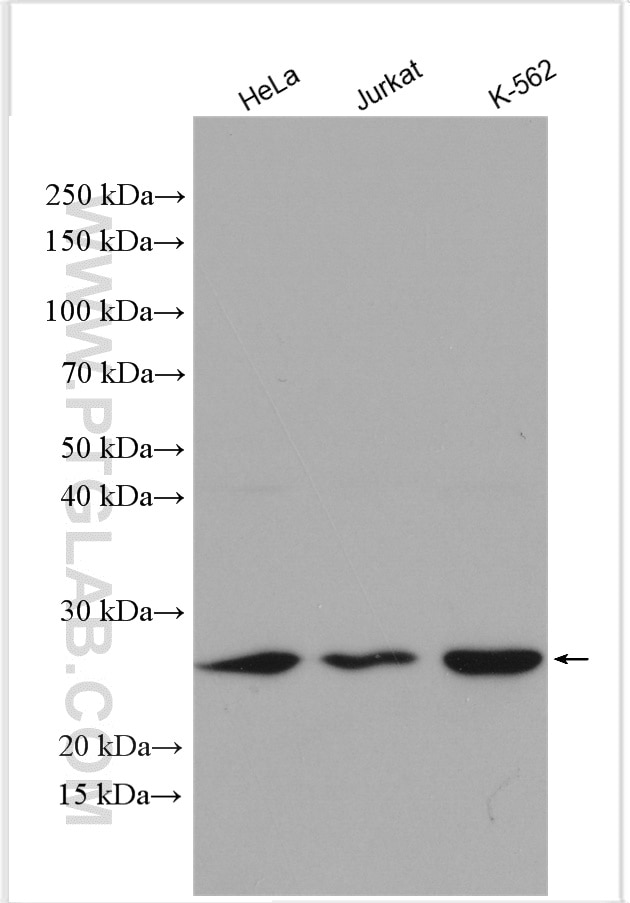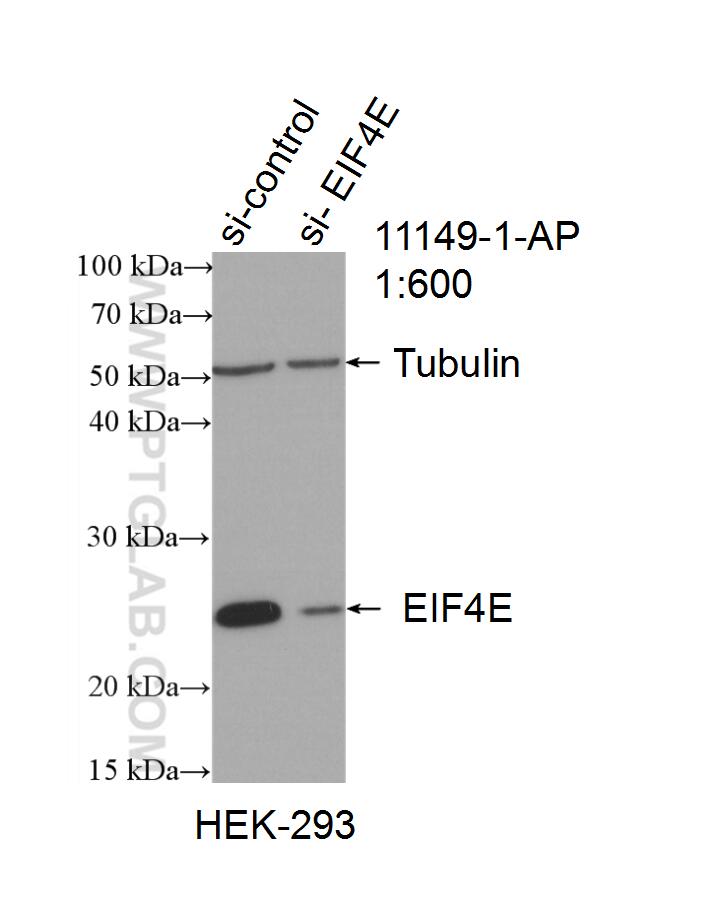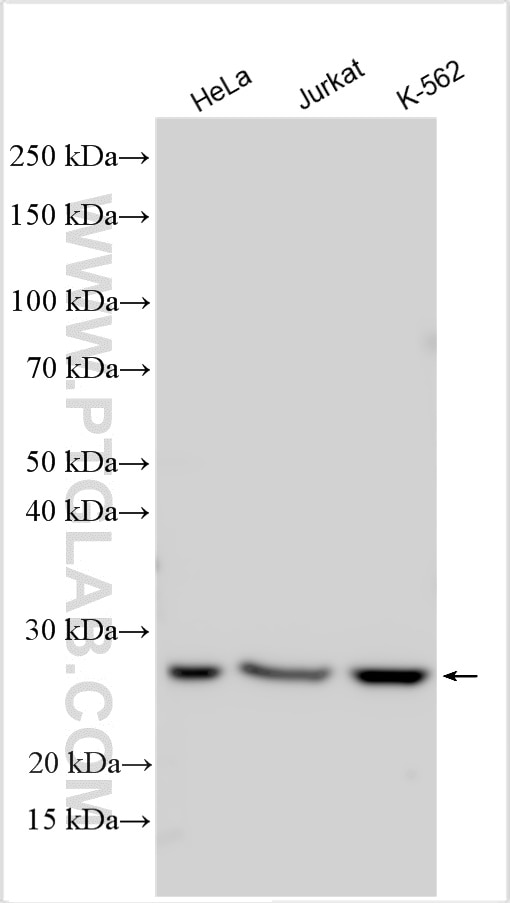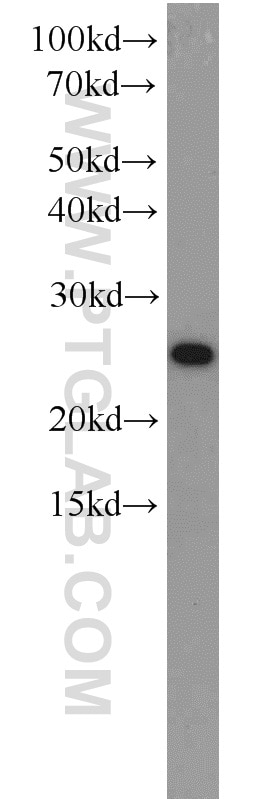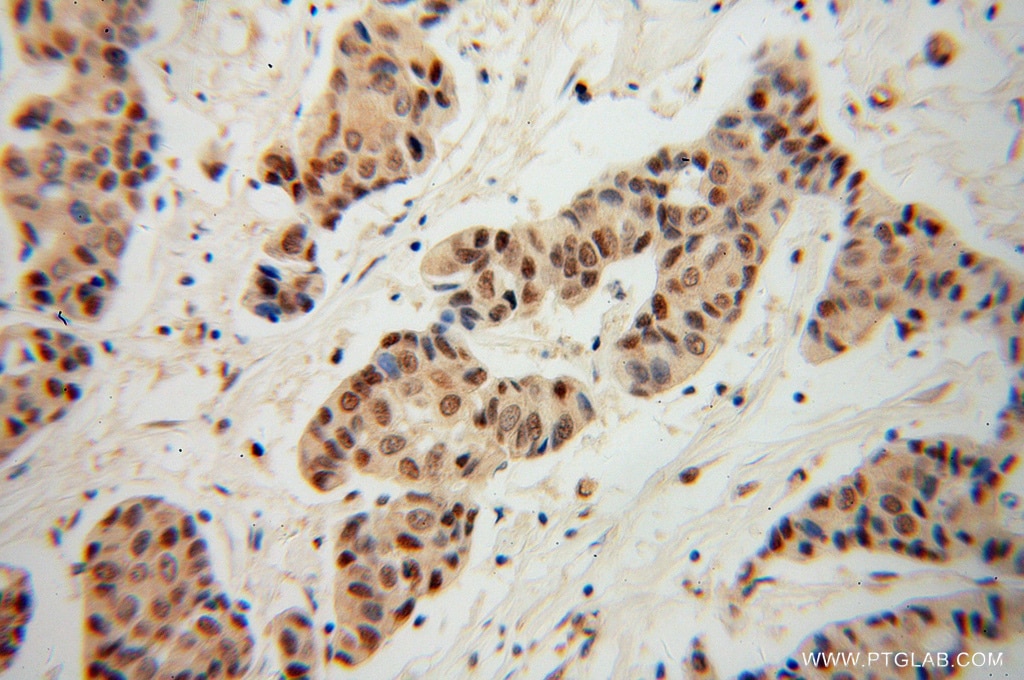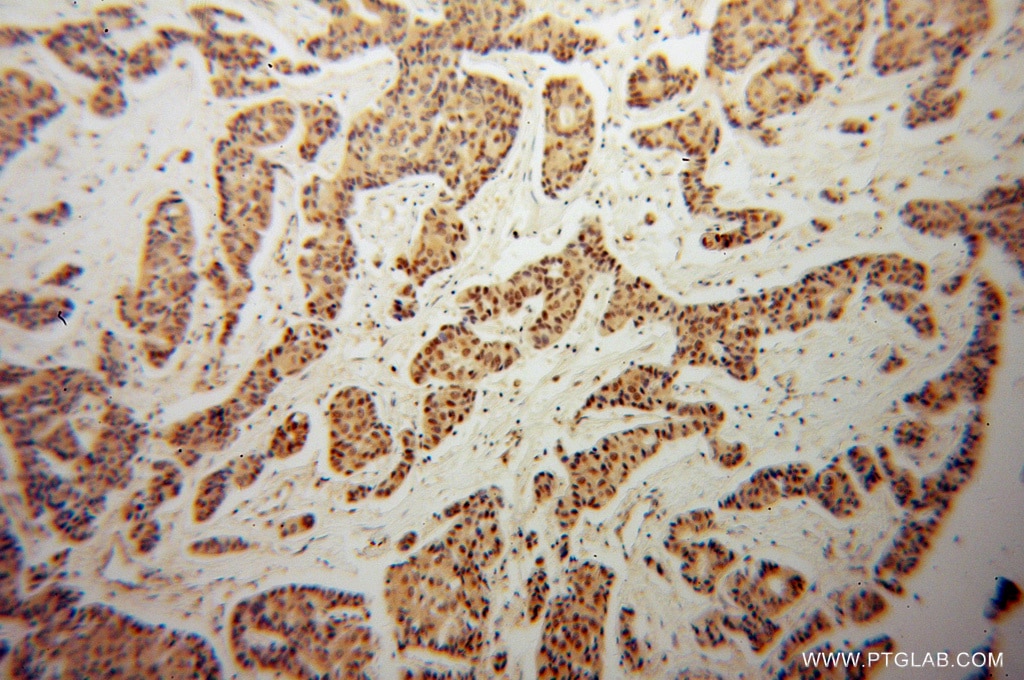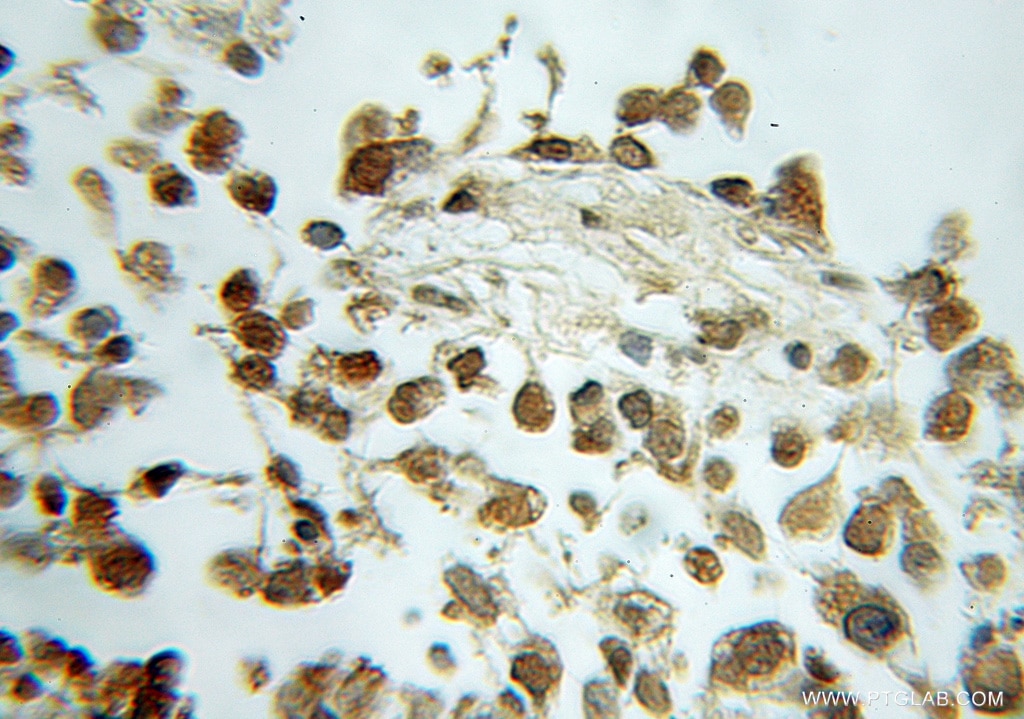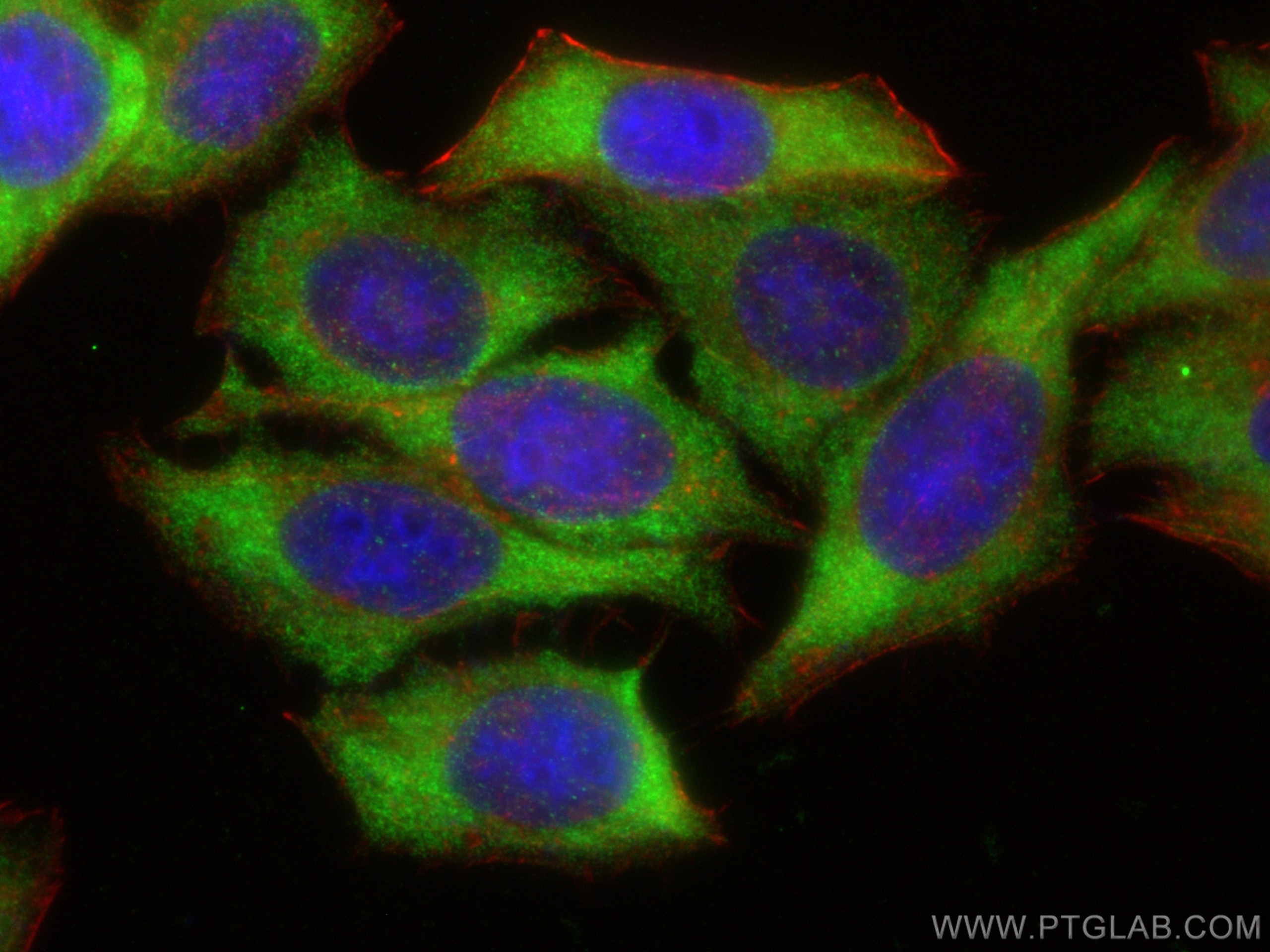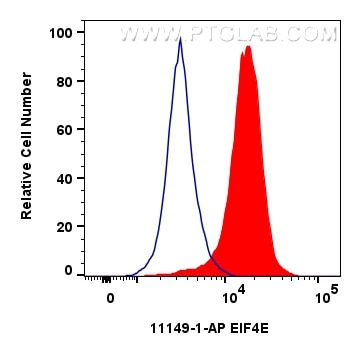- Phare
- Validé par KD/KO
Anticorps Polyclonal de lapin anti-EIF4E
EIF4E Polyclonal Antibody for WB, IHC, ELISA, IF/ICC, FC (Intra)
Hôte / Isotype
Lapin / IgG
Réactivité testée
Humain et plus (1)
Applications
WB, IHC, ELISA, IF/ICC, FC (Intra)
Conjugaison
Non conjugué
N° de cat : 11149-1-AP
Synonymes
Galerie de données de validation
Applications testées
| Résultats positifs en WB | cellules HeLa, cellules HEK-293, cellules Jurkat, cellules K-562 |
| Résultats positifs en IHC | tissu de cancer du sein humain, tissu de gliome humain il est suggéré de démasquer l'antigène avec un tampon de TE buffer pH 9.0; (*) À défaut, 'le démasquage de l'antigène peut être 'effectué avec un tampon citrate pH 6,0. |
| Résultats positifs en IF/ICC | cellules HepG2, |
| Résultats positifs en FC (Intra) | cellules HeLa, |
Dilution recommandée
| Application | Dilution |
|---|---|
| Western Blot (WB) | WB : 1:1000-1:4000 |
| Immunohistochimie (IHC) | IHC : 1:20-1:200 |
| Immunofluorescence (IF)/ICC | IF/ICC : 1:200-1:800 |
| Flow Cytometry (FC) (INTRA) | FC (INTRA) : 0.40 ug per 10^6 cells in a 100 µl suspension |
| It is recommended that this reagent should be titrated in each testing system to obtain optimal results. | |
| Sample-dependent, check data in validation data gallery | |
Applications publiées
| WB | See 20 publications below |
| IHC | See 1 publications below |
| IF | See 1 publications below |
Informations sur le produit
11149-1-AP cible EIF4E dans les applications de WB, IHC, ELISA, IF/ICC, FC (Intra) et montre une réactivité avec des échantillons Humain
| Réactivité | Humain |
| Réactivité citée | Humain, souris |
| Hôte / Isotype | Lapin / IgG |
| Clonalité | Polyclonal |
| Type | Anticorps |
| Immunogène | EIF4E Protéine recombinante Ag1626 |
| Nom complet | eukaryotic translation initiation factor 4E |
| Masse moléculaire calculée | 29 kDa |
| Poids moléculaire observé | 26-29 kDa |
| Numéro d’acquisition GenBank | BC012611 |
| Symbole du gène | EIF4E |
| Identification du gène (NCBI) | 1977 |
| Conjugaison | Non conjugué |
| Forme | Liquide |
| Méthode de purification | Purification par affinité contre l'antigène |
| Tampon de stockage | PBS avec azoture de sodium à 0,02 % et glycérol à 50 % pH 7,3 |
| Conditions de stockage | Stocker à -20°C. Stable pendant un an après l'expédition. L'aliquotage n'est pas nécessaire pour le stockage à -20oC Les 20ul contiennent 0,1% de BSA. |
Informations générales
Eukaryotic translation initiation factor 4E, also known as eIF4E, is a protein that in humans is encoded by the EIF4E gene. eIF4E is the mRNA cap-binding protein, known as a general initiation factor allowing for mRNA-ribosome interaction and cap-dependent translation in eukaryotic cells. eIF4E is a polypeptide that exists as both a free form and as part of the eIF4F pre-initiation complex. Regulation of eIF4E may be achieved via three distinct mechanisms: transcription, phosphorylation, and inhibitory proteins. This is a rabbit polyclonal antibody raised against the full-length human EIF4E.
Protocole
| Product Specific Protocols | |
|---|---|
| WB protocol for EIF4E antibody 11149-1-AP | Download protocol |
| IHC protocol for EIF4E antibody 11149-1-AP | Download protocol |
| IF protocol for EIF4E antibody 11149-1-AP | Download protocol |
| FC protocol for EIF4E antibody 11149-1-AP | Download protocol |
| Standard Protocols | |
|---|---|
| Click here to view our Standard Protocols |
Publications
| Species | Application | Title |
|---|---|---|
Cancer Res HBXIP and LSD1 Scaffolded by lncRNA Hotair Mediate Transcriptional Activation by c-Myc. | ||
Nucleic Acids Res SUMOylation of the m6A-RNA methyltransferase METTL3 modulates its function. | ||
Mol Ther RNA m6A methylation regulates the dissemination of cancer cells via modulating expression and membrane localization of β-catenin. | ||
Theranostics KDM6A promotes imatinib resistance through YY1-mediated transcriptional upregulation of TRKA independently of its demethylase activity in chronic myelogenous leukemia. | ||
Cell Death Dis Multifunctional viral protein γ34.5 manipulates nucleolar protein NOP53 for optimal viral replication of HSV-1. | ||
ACS Chem Neurosci Quercitrin Rapidly Alleviated Depression-like Behaviors in Lipopolysaccharide-Treated Mice: The Involvement of PI3K/AKT/NF-κB Signaling Suppression and CREB/BDNF Signaling Restoration in the Hippocampus |
